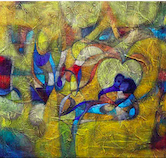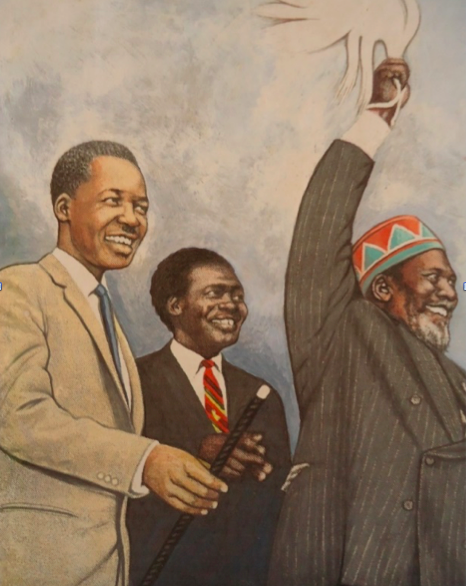Modern Art in East Africa is unique in its aesthetic compositions as well as its conceptual underpinnings. In Kenya, the process of modernisation in the late nineteenth and early twentieth centuries was brief, occurred within one or two generations, and in chaotic and violent circumstances. The social and cultural upheaval, which colonised Kenyans experienced as a result of colonial intervention and subsequent industrialization and modernisation “destroyed or half-destroyed a great deal which must now be re-examined to see if it is salvageable” (John Roberts, 1967:199).
One particular example of this cultural rupture is the fact that the majority of Eastern Africa’s early modernists were professing, and in some cases devout Christians, rather than adherents of local religions. The historian Toyin Falola considers Christianity a unified religion, which paradoxically disrupted “systems and cultures that were in place for thousands of years prior and uniquely tailored to suit the people and environment of the land.’’ As a result of the aggressive suppression of local religious and cultural practices by colonial missionaries and agents of Empire, many modern Kenyans repudiated the pre-colonial worldviews and cosmologies of their non-Christian forebears.

![[FIG 01] Elkana Ong’esa, Untitled, Undated, Soapstone Sculpture. Photograph courtesy of the artist and African Heritage House](https://eaman.belvadigital.com/wp-content/uploads/2024/08/COVER-IMAGE_FIG-01_01_-Elkana-Ongesa-Soapstone.webp)
![[FIG 02] Gregory Maloba, Untitled, Concrete Sculpture, Circa 1972. Maloba was Kenya’s first indigenous artist to study towards a Bachelor of Fine Art in 1940.](https://eaman.belvadigital.com/wp-content/uploads/2024/08/Fig_02_01_Gregory-Maloba_Untitled_Concrete-Scultpute_Circa-1972_Safari-Park-Hotel-Nairobi_Photograph-by-Muhunyo-Maina-scaled.jpg)
![[FIG 03] Elkana Ong’esa, ‘Elephant Family’, Soapstone sculpture, 2018.](https://eaman.belvadigital.com/wp-content/uploads/2024/08/Fig-3_01_Elkana-Ongesa_Elephant-Family_2018_soapstone-sculpture_Uhuru-Gardens-Nairobi_photograph-by-Margaretta-Swigert-Gacheru.jpg)
![[FIG 04] Wosene Kosrof, The Preacher III, 2000, Acrylic on canvas. Photograph courtesy of the National Museum of African Art, Smithsonian.](https://eaman.belvadigital.com/wp-content/uploads/2024/08/FIG_04-_01-_Wosene-Kosrof_-‘The-Preacher-III_-2000_Courtesy-of-the-National-Museum-of-African-Art.-1-1.jpg)
![[FIG 05] Portrait of Elimo Njau painting the ‘Murang’a Murals’ at the Cathedral of St James & All Martyrs, Murang'a in 1959.](https://eaman.belvadigital.com/wp-content/uploads/2024/08/Fig-05_01_-Elimo-Njau_Portrait-at-the-Cathedral-of-St-James-All-Martyrs_Murang_a_1959-.jpg)
![[FIG 06] Eli Kyeyune, ‘Hairdressing’, 1975, Oil on Board.](https://eaman.belvadigital.com/wp-content/uploads/2024/08/Fig-06_01_Eli-Kyeyune_Hairdressing_1975_Oil-on-Board.png)
![[FIG 08] Mutisya Munge, Askari figure, circa 1920, wooden sculpture, Courtesy of Stevenson Gallery](https://eaman.belvadigital.com/wp-content/uploads/2024/08/Fig-09_01_Mutisya-Munge_An-Askari-figure_wooden-sculpture_circa-1920_Courtesy-of-Stevenson-Gallery.jpg)
![[FIG 09] Unrecorded Zaramo artist, Zaramo Statue, wooden sculpture, private collection. Courtesy of Galerie Memoires 2022](https://eaman.belvadigital.com/wp-content/uploads/2024/08/Fig-10_01_Unrecorded-Zaramo-artist_Zaramo-Statue_wooden-sculpture_private-collection_courtesy-of-Galerie-Memoires-2022.jpg)
![[FIG 10] Edward Njenga, No Vacancy, 1970, Terracotta Sculpture. Photograph courtesy of the East Africa Art Auction.](https://eaman.belvadigital.com/wp-content/uploads/2024/08/Fig_11_01_Edward-Njenga_No-Vacancy_terracota-sculpture_1970.jpg)

